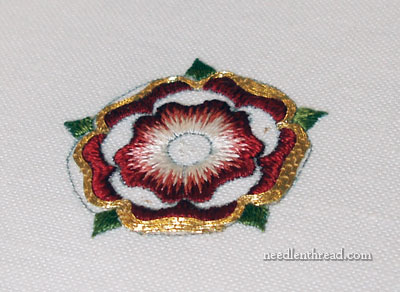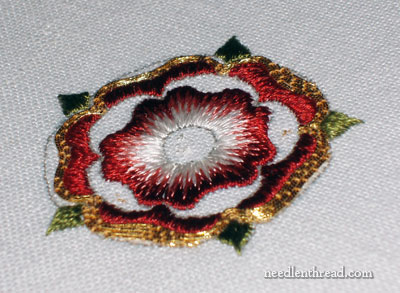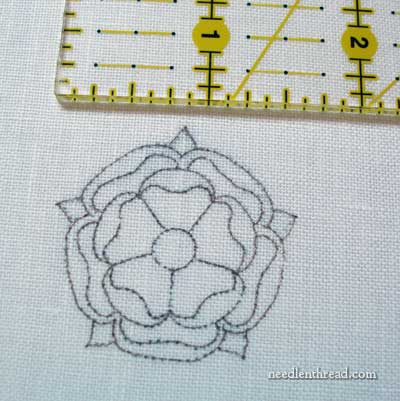The last couple days, I’ve been working out the details for the small rose motif that’s repeated on the current ecclesiastical embroidery project I’m working on.
And really, when I say the last couple days, I mean just that – two days. Two! Sure, we’re not talking about stitching 24 hours a day, but all my stitching time has been devoted to this one thing for two days, and – woe is me! – I haven’t even finished the thing!

Now, this particular rose is not actually embroidered onto the design. This is just a test piece, to make sure I like the threads I’ve selected, and to work through the motif so that I can teach it to someone else. I want to make sure I’ve worked my way through any difficult areas so that I can guide the student through the tough spots more easily.
Testing is always important. But wow. It can eat up your stitching time!
Still – it’s worth it!

Given the last two cloudy days, I haven’t had a chance to take a photo in the sunshine, so it’s hard to catch the gleam of the gold and the silk. This photo’s a bit better.
I’m working the motif with three colors of Soie de Paris – a dark brickish red, a rose, and cream. The color numbers are 2636, 2914, and creme. I could’ve gone with more shades of color in a different silk, but I like the look of Soie de Paris in long and short stitch and in satin stitch, and these three colors work well together. Besides, more than three colors would not have fit in the long and short stitch petals in the center. The rose is kind of small!
For gold thread, I’m using gold tambour thread #7, which is a synthetic thread, and non-tarnishing. It’s a fine thread that’s quite flexible and soft, so it fits into these small spaces well. The center will be filled with chip work encircled with pearl purl.
Hopefully, the rose will be finished before the sun goes down today. I’ll show it to you when it’s finished, and then take you step-by-step through working the piece.

Here’s the scale of the flower. You can see that it’s about 1.5″ from leaf tip to leaf tip. It’s not microscopically tiny, but it’s small enough!
Questions, comments, suggestions? Have your say below!







Hi Mary!
Ooohhhh! I absolutely love the colors! Thank you for listing the numbers for the thread. This is definitely a favorite flower that you have made. Simply beautiful. I will have to try to make one of those sometime!
Thank you for showing us. Looking forward to seeing more of this project:-)
Good day 🙂
Mindi Hammerstone
Wow. This is simply beautiful. I cannot wait to see it with the chips in the center. Your work is so inspirational and it is really kind of you to share it and your methods with the rest of us.
Thank you,
Amy in upstate NY
Mary your dedication to the art of embroidery and preparation for teaching are second to none.
I wish I were able to have a teacher such as yourself as what I learn is from the daily posts and I feel so honoured that you share what you do with us all.
Thank-you
Linda
It’s really beautiful! I just love that flower pattern, and your color choice is really lovely. This is where those long and short stitch lessons come in handy! I can imagine the time it takes to work through lessons. I’m glad you’re the teacher and not me! 🙂
Hi Mary,
Thanks so much for mentioning how long the small flower took you to work. I know that a hobby is supposed to be about process rather than production, but sometimes I get impatient with myself for being so slow. It’s good to know that accomplished needleworkers are also “slow” and perhaps this is part of what makes the work so beautiful.
Mary, this is so pretty. I really like Tudor Roses, I suppose that they are so often worked in silk and goldwork is part of the reason they appeal to me.
The three colours of Soie de Paris look great together (and with gold).
As an English transplant I am all in favour of Tudor roses everywhere. However, I think on this one I would really like to see a little more of the pink. It seems a bit dark, although, as you say, that may be the lighting. Otherwise it is beautiful. I wish I could stitch as well as you do in such tiny spaces and get such a wonderful finish.
Dear Mary
What a beautiful rose and so much preparation put into a samplar and I agree with Linda I also wish you were here in North London teaching embroidery, your daily posts are an inspiration, thanks so much for your dedication to the art of embroidery and your dedication to those of us who are just learning.
Regards anita
wow!!! so beautiful!
dear Mary,every day I enjoy your blog- I like embroidery very much, but have at the moment not the time to do it myself. What you publish is always so inspiring,it keeps my awake (and lurching for a time-window to start with an new project, there are enough ideas….) Thank you very much!
martina
Mary, another delight to view. I’m looking forward to the step by step.
I do test pieces, too, sometimes. Especially if I’ve never worked the shape or the materials before and even if it’s only part of the design, like a petal or leaf or something. It’s worth the time in the end, I think.
Simply Gorgeous!
Wish I could take the class from you.
Jaw-droppingly beautiful. Literally. My jaw dropped. I’m working my way through your long and short stitch tutorial, and I so admire your teaching ability as well as your color sense (well, and your skill at embroidery!).
Your work is so beautiful, but what do you do with all these samples you make. They use up a lot of thread and gold..Just curious.
I love the colors and the stitching in the middle where you blended with long and short satin stitches or whatever the proper name is, is done EXQUISITELY! I always admire when blending is done so well. I always shy away from those types of areas or patterns that require it because I feel it’s the hardest thing to do well.
Thanks for letting me admire it.
Hi Mary,
That’s beautiful! Will you tell us what stitch you used with the gold thread? I can’t wait to see the finished piece tomorrow. Where did you find your ruler,shown in the last photo? It looks like it would be very useful. Thank you for sharing your amazing work!
Hi Mary,
wow! it is beautiful& i liked the color combination.Iam eagerly waiting for step by step.
love it!
Hi Mary:
I love your Tudor Rose and the use of goldwork! Even though Mom said “don’t criticize unless you can do it better yourself”, and even though I know I cannot do it better, I find myself asking why you used an outline (black) around the inner petals? IMO it looks like one blossom is sitting on top the other, hence two blossoms rather than one.
Karen J
Hi, All – Thanks so much for your comments on this post…. I’ll try to answer some questions here:
Hi, Karen – I’m thinking you’re talking about on the finished piece that I posted today (July 11)? In the finished piece, it’s a darker red, using a 100/3 silk, in a stem stitch, around the middle petals. You’re right, the purpose is to help “lift” the inner petals a little above the background petals.
Hi, Susie – the gold threads are simply couched on, in pairs. So it’s just a straight little stitch over a pair of the gold threads, to hold them in place.
Hi, Mary Jane – What do I do with samples? Most of my samples go into a folder, so I can use them for reference later on. Occasionally, I might “do” something with them – I’ve turned samples into needlecases, for example – but for the most part, I use them for reference. I can go back and see what stitches I used, what techniques, what threads, for a given effect, and reproduce that effect without having to ponder too much about what supplies I “might have used” on a particular piece, etc.
~MC
Just a wee comment. I was so surprised to see this particular pattern. The pattern reminds me very strongly of Luther’s rose (http://www.elca.org/Growing-In-Faith/Discipleship/Christian-Education/Program-Planners/2009/Luther-Rose.aspx). I do love your rendition, Mary. Thank you!
Hello
Just had to send you some praise for your embroidery project. Came across the image quite by chance in trying to reproduce the Tudor Rose for some Church artwork I’m doing – amateur work that is – your design and colours are simply wonderful.
Helen Powlesland Credton England
I share your love of roses in embroidery Mary, especially the Tudor Rose. I am not a flowery dresser, just love flowers in the garden and embroidery
Do you have a pattern with good instructions. I’d love to do this
The whole project, design and all, is detailed in the posts on this page: https://www.needlenthread.com/2011/07/goldwork-silk-tudor-style-rose-tutorials-index.html
This project is also contained in this downloadable PDF e-book: https://shop.needlenthread.com/product/the-marian-medallion-project-from-design-to-delivery since it was part of that project.